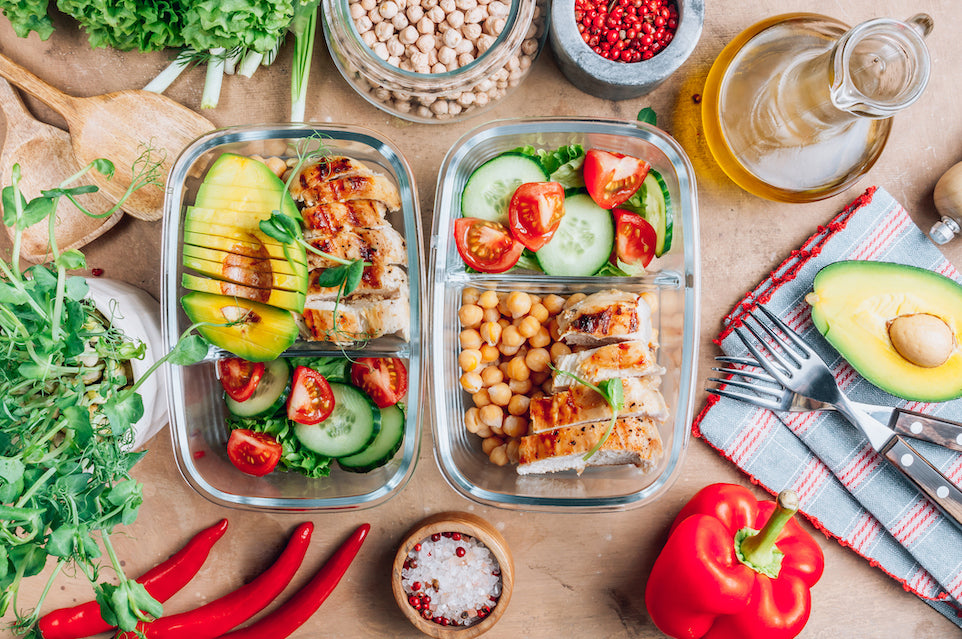Eating out, ordering in, traveling, and socializing in situations where someone else prepares your food do not have to derail your eating plan. The keys to staying on course are planning, maintaining your muscle-centric routine the rest of the day, and keeping a positive mindset.
1. Plan ahead to make the best choices.
- If you will be eating at a restaurant, ordering take-out or hotel room service, or picking up a meal from a grocery store, look at the menu online in advance. Commit to your selection ahead of time. Check item descriptions and nutrition information if it is available.
-
-
Review the main dish options to choose a source of quality protein, such as beef, pork, chicken, seafood, or tofu.
-
-
-
-
Go for items described as broiled, baked, steamed, poached, and grilled. Side-step breaded, battered, creamy, and fried foods.
-
-
-
-
-
Compare nutrition information if available. More protein is better (at least 30 grams at a meal), and less is best for calories, carbs, fat, and sodium.
-
-
-
-
Plan your quality carbs. Look for 2 non-starchy vegetables you could order, such as a leafy green salad, brussels sprouts, asparagus, or green beans.
-
-
-
Ask for dressings and sauces on the side so you can control the amount of added fat.
-
-
Think your drink.
- Whether at home or away, drink plenty of water to keep well-hydrated.
-
Avoid sugar-sweetened beverages.
- Sugar is not a quality carb and too much will throw off your carb balance.
- Sugary drinks (both hot and cold) contain lots of “empty” calories that can add up significantly.
- Click here for tips to slash sugar from your beverage routine.
-
We recommend generally avoiding alcohol, but if you do choose to drink:
- Do so in moderation: 2 drinks per day for men and 1 per day for women.
- One drink = 1.5 oz. 80 proof distilled spirits (1 oz. if 100 proof), 5 oz. wine, or 12 oz. beer.
- Try to have a lower carb alcoholic beverage, if available.
-
Check out the resources below for more guidance for choosing power proteins and making balanced quality carb choices:
- Ordering meals from a variety of types of restaurants;
- Selecting meals prepared by a grocery store;
- Eating in others’ homes, such as dinner parties;
- Packing a muscle-centric lunch to take to work instead of eating at the worksite cafeteria, ordering take-out, or going out to lunch; and
- Packing travel-friendly foods for a road trip or air travel. If you don’t pack them, check in convenience stores, drug stores, and at the hotel or airport while you are traveling.
2. Maintain your muscle-centric routine the rest of the day.
-
Try to start your day with a high protein balanced breakfast within 90 minutes of waking. If you will be attending a breakfast event and you anticipate limited protein options (tip off – Continental breakfast!), consider:
-
Eating a protein-focused breakfast before you go, and plan to enjoy some coffee or tea and a very light snack at the event.
-
You could say, “I got hungry very early and could not wait for breakfast” if someone asks why you’re not eating much.
-
-
If your away from home event is later in the day or in the evening, focus on eating smart earlier in the day. You could eat lighter meals before the event (but still prioritize eating at least 30 grams of protein at each meal) so you can eat a little more or enjoy a drink at the event and still stick to your daily calorie target.
-
Strive to eat meals 3 – 5 hours apart. Adjust accordingly for the time of your event. For example, if you eat 3 meals a day and:
-
Breakfast is at 9 AM and you will meet for dinner at 7 PM, then try to eat a mid-day meal around 2 PM.
-
Breakfast is at 7 AM and dinner is at 8 PM, then target a smaller mid-day meal around noon (eat at least 30 grams of quality protein) and eat a small muscle-centric snack around 4 PM to keep you satisfied until dinner.
-
3. Keep a positive mindset.
-
Your plan is a commitment to a muscle-centric eating pattern. You may strive for perfection “one meal at a time,” yet strive for progress rather than perfection.
-
If you eat away from home infrequently (such as just on holidays and other special occasions), then a few “off plan” meals are less important in the big picture.
-
Make more effort to stick to your plan if you eat away from home often. For example:
-
You often attend business meetings at restaurants or other venues where food will be served.
-
You have standing social commitments, such as friends’ night out once a week.
-
You regularly eat at someone’s home, such as family dinner every Sunday.
-
-
Use the planning tips above so you can stress less about food and focus more on connecting with others and having fun.
-
Remember − if your plan goes awry, get back on track tomorrow.
Conclusion
Eating away from home can be both an enjoyable and healthy experience. It can give you a chance to try new foods and enjoy those you know you love, but don’t typically eat at home. Plan ahead to make the best choices and avoid stress so you can focus on having fun and staying on top of your game. If your plan goes away, you can get back on track the next day.





Leave a comment
This site is protected by hCaptcha and the hCaptcha Privacy Policy and Terms of Service apply.